福州大学:《现代大学英语精读》课程PPT教学课件(精读F)B7 Unit 5 French and English
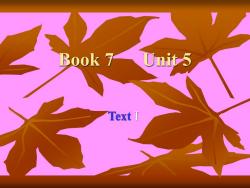
Book 7 Unit 5 Text I
Book 7 Unit 5 TextⅠ
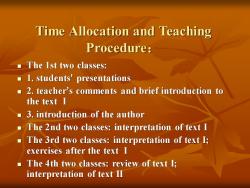
Time Allocation and Teaching Procedure: The 1st two classes: 1.students'presentations 2.teacher's comments and brief introduction to the text I 3.introduction of the author The 2nd two classes:interpretation of text I ■ The 3rd two classes:interpretation of text I; exercises after the text I The 4th two classes:review of text I; interpretation of text II
Time Allocation and Teaching Procedure: ◼ The 1st two classes: ◼ 1. students’ presentations ◼ 2. teacher’s comments and brief introduction to the text I ◼ 3. introduction of the author ◼ The 2nd two classes: interpretation of text I ◼ The 3rd two classes: interpretation of text I; exercises after the text I ◼ The 4th two classes: review of text I; interpretation of text II
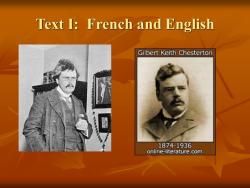
Text I:French and English Gilbert Keith Chesterton 18741936 online-literature.com
Text I: French and English
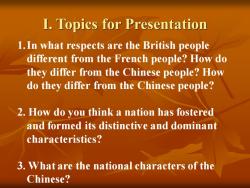
I.Topics for Presentation 1.In what respects are the British people different from the French people?How do they differ from the Chinese people?How do they differ from the Chinese people? 2.How do you think a nation has fostered and formed its distinctive and dominant characteristics? 3.What are the national characters of the Chinese?
I. Topics for Presentation 1.In what respects are the British people different from the French people? How do they differ from the Chinese people? How do they differ from the Chinese people? 2. How do you think a nation has fostered and formed its distinctive and dominant characteristics? 3. What are the national characters of the Chinese?
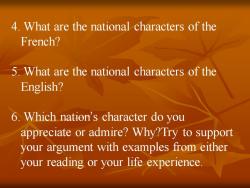
4.What are the national characters of the French? 5.What are the national characters of the English? 6.Which nation's character do you appreciate or admire?Why?Try to support your argument with examples from either your reading or your life experience
4. What are the national characters of the French? 5. What are the national characters of the English? 6. Which nation’s character do you appreciate or admire? Why?Try to support your argument with examples from either your reading or your life experience

Ⅱ.About the author Gilbert Keith Chesterton (1874-1936)was a prolific English critic and author of verse, essays,novels,and short stories.He is probably best known for his series about the priest-detective Father Brown who appeared in 50 stories.Between 1900 and 1936 Chesterton published some one hundred books. ■ Chesterton was a prolific English writer of the early 20th century.He was both a popular and an influential writer during this period
II. About the author ◼ Gilbert Keith Chesterton (1874-1936) was a prolific English critic and author of verse, essays, novels, and short stories. He is probably best known for his series about the priest-detective Father Brown who appeared in 50 stories. Between 1900 and 1936 Chesterton published some one hundred books. ◼ Chesterton was a prolific English writer of the early 20th century. He was both a popular and an influential writer during this period

inspiring many historic figures with his works. He was notably concerned in what he wrote with religious matters,and was received into the Catholic Church in 1922.Chesterton has been called the "prince of paradox".He wrote in an off-hand,whimsical prose studded with startling formulations.For example:"Thieves respect property.They merely wish the property to become their property that they may more perfectly respect it
◼ inspiring many historic figures with his works. He was notably concerned in what he wrote with religious matters, and was received into the Catholic Church in 1922. Chesterton has been called the "prince of paradox". He wrote in an off-hand, whimsical prose studded with startling formulations. For example: "Thieves respect property. They merely wish the property to become their property that they may more perfectly respect it
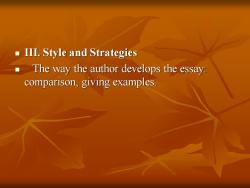
III.Style and Strategies The way the author develops the essay: comparison,giving examples
◼ III. Style and Strategies ◼ The way the author develops the essay: comparison, giving examples
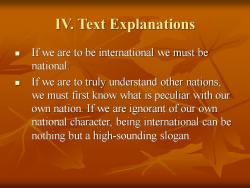
IV.Text Explanations If we are to be international we must be national. If we are to truly understand other nations, we must first know what is peculiar with our own nation.If we are ignorant of our own national character,being international can be nothing but a high-sounding slogan
IV. Text Explanations ◼ If we are to be international we must be national. ◼ If we are to truly understand other nations, we must first know what is peculiar with our own nation. If we are ignorant of our own national character, being international can be nothing but a high-sounding slogan

And it is largely because those who call themselves the friends of peace have not dwelt sufficiently on this distinction that they do not impress the bulk of any of the nations to which they belong. Those who claim to be the friends of peace haven't acquired a thorough knowledge about the distinction between different nations,and thus their efforts made in pursuing international peace can bear no fruits even in their own nations
◼ And it is largely because those who call themselves the friends of peace have not dwelt sufficiently on this distinction that they do not impress the bulk of any of the nations to which they belong. ◼ Those who claim to be the friends of peace haven’t acquired a thorough knowledge about the distinction between different nations, and thus their efforts made in pursuing international peace can bear no fruits even in their own nations
按次数下载不扣除下载券;
注册用户24小时内重复下载只扣除一次;
顺序:VIP每日次数-->可用次数-->下载券;
- 福州大学:《现代大学英语精读》课程PPT教学课件(精读F)B7 Unit 3 Oxford.ppt
- 福州大学:《现代大学英语精读》课程PPT教学课件(精读F)B7 Unit 2 Pain is not the Ultimate Enemy.ppt
- 福州大学:《现代大学英语精读》课程PPT教学课件(精读F)B7 Unit 1 Neat People vs. Sloppy People.ppt
- 福州大学:《现代大学英语精读》课程PPT教学课件(精读F)B7 Unit 4 Text I On the Art of Living with Others.ppt
- 福州大学:《现代大学英语精读》课程PPT教学课件(精读F)B7 Unit 10 On Self-Respect.ppt
- 福州大学:《现代大学英语精读》课程PPT教学课件(精读E)B6 Unit 10 On Reading.ppt
- 福州大学:《现代大学英语精读》课程PPT教学课件(精读E)B6 Unit 8 Text 1 How to Grow Old.ppt
- 福州大学:《现代大学英语精读》课程PPT教学课件(精读E)B6 Unit 5(IGE)What Are Our Real Values?.ppt
- 福州大学:《现代大学英语精读》课程PPT教学课件(精读E)B6 Unit 2(IGE 6)Disney World:Cities of Simulation as Postmodern Utopias.ppt
- 福州大学:《现代大学英语精读》课程PPT教学课件(精读E)B6 Unit 1 Technology in Reverse.ppt
- 福州大学:《现代大学英语精读》课程PPT教学课件(精读E)B6 Unit 9 My Wood.ppt
- 福州大学:《现代大学英语精读》课程PPT教学课件(精读E)B6 Unit 7 Text1 Two Truths to Live By.ppt
- 福州大学:《现代大学英语精读》课程PPT教学课件(精读E)B6 Unit 6 Text I I’d Rather Be Black Than Female.ppt
- 福州大学:《现代大学英语精读》课程PPT教学课件(精读E)B6 Unit 5 Text I Being There By Anatole Broyard.ppt
- 福州大学:《现代大学英语精读》课程PPT教学课件(精读E)B6 Unit 4 Text I A Few Kind Words for Superstition By Roberson Davies.ppt
- 福州大学:《现代大学英语精读》课程PPT教学课件(精读D)Unit 8 Love and Resentment.ppt
- 福州大学:《现代大学英语精读》课程PPT教学课件(精读D)Unit 4 Force of Nature.ppt
- 福州大学:《现代大学英语精读》课程PPT教学课件(精读D)Unit 3 A Hanging.ppt
- 福州大学:《现代大学英语精读》课程PPT教学课件(精读D)Unit 9 Kids and Computers:Digital Danger.ppt
- 福州大学:《现代大学英语精读》课程PPT教学课件(精读D)Unit 13 The Battle of the Ants.ppt
- 福州大学:《现代大学英语精读》课程PPT教学课件(精读F)B7 Unit 6 A Statement to My people on the Eve of War.ppt
- 福州大学:《现代大学英语精读》课程PPT教学课件(精读F)B7 Unit 7 Chinese Humanism.ppt
- 福州大学:《现代大学英语精读》课程PPT教学课件(精读F)B7 Unit 8 Mr. Preble Gets Rid of His Wife.ppt
- 福州大学:《现代大学英语精读》课程PPT教学课件(精读F)B7 Unit 9 The Artist in America.ppt
- 海南大学:《大学英语》课程教学大纲(非英语专业本科用).pdf
- 海南大学:《大学英语》课程授课教案(PPT课件)Unit 1 Writing for Myself.ppt
- 海南大学:《大学英语》课程授课教案(PPT课件)Unit 2.ppt
- 海南大学:《大学英语》课程授课教案(PPT课件)Unit 6 What Animals Really Think.ppt
- 海南大学:《大学英语》课程授课教案(PPT课件)Unit 4 Tony Trivisonno’s American Dream.ppt
- 海南大学:《大学英语》课程授课教案(PPT课件)Unit 5 A VALETINE STORY.ppt
- 海南大学:《大学英语》课程授课教案(PPT课件)Unit 7 KIDS ON THE TRACK.ppt
- 海南大学:《大学英语》课程授课教案(PPT课件)Unit 8 FABLE OF THE LAZY TEENAGER.ppt
- 海南大学:《大学英语》课程授课教案(课件讲稿)Unit 3.pdf
- 福州大学:《翻译》课程教学资源(教学大纲)翻译实践教学大纲.pdf
- 福州大学:《翻译》课程教学资源(教学大纲)汉译英教学大纲 Chinese-English Translation.pdf
- 福州大学:《翻译》课程教学资源(教学大纲)高级口译教学大纲 Advanced Oral Interpreting.pdf
- 福州大学:《翻译》课程教学资源(教学大纲)英译汉教学大纲 English-Chinese Translation.pdf
- 福州大学:《翻译》课程教学资源(教学大纲)中级口译教学大纲 Intermediate Course of English-Chinese Interpretation.pdf
- 福州大学:《翻译》课程教学资源(教学大纲)实用翻译教学大纲 Pragmatic Translation.pdf
- 福州大学:《翻译》课程教学资源(授课教案)翻译实践课程教案 Teaching Notes for Translation Practices.pdf
